Are you ready to unearth the secrets of successful vegetable gardening? Whether you have a small backyard or a sunny balcony, growing your own vegetables is a rewarding and fulfilling experience. But where do you start? In this guide, I’ll share essential tips, tricks, and best practices for beginner vegetable gardeners. By following these vegetable growing tips, you’ll be well on your way to nurturing a bountiful and thriving garden.
Key Takeaways:
- Start small and gradually expand your garden as you gain experience.
- Choose a sunny location with well-drained soil and protection from strong winds.
- Plan your garden layout and consider using raised beds for easier maintenance.
- Select beginner-friendly vegetables that are suited to your climate.
- Learn how to start seeds and transplant seedlings for optimal growth.
- Master the art of watering and fertilizing to keep your plants healthy.
- Implement organic pest and disease management strategies for a thriving garden.
- Harvest your vegetables at the right time and store them properly for long-lasting freshness.
- Troubleshoot common garden issues such as plant diseases and nutrient deficiencies.
By following these vegetable growing tips and adopting a beginner-friendly approach, you’ll be well-equipped to create a successful vegetable garden. Get ready to dig into the world of vegetable gardening and reap the delicious rewards of your own homegrown produce!
Why Start a Vegetable Garden?
There are countless reasons why you should start a vegetable garden, from enjoying the best-tasting vegetables and fruits to experiencing the satisfaction of growing your own food. Not only will you have access to fresh, homegrown produce, but you’ll also have the opportunity to connect with nature and nurture a new hobby. Vegetable gardening provides numerous benefits, both for your physical well-being and your overall enjoyment of the outdoors.
The Joy of Homegrown Produce
One of the most rewarding aspects of vegetable gardening is being able to harvest and enjoy the fruits (or in this case, vegetables) of your labor. There’s nothing quite like the taste of a ripe tomato or a crisp cucumber straight from the garden. The flavors and textures of homegrown produce are often superior to what you find in the grocery store, as they are picked at the peak of freshness and don’t undergo lengthy transportation or storage.
“If you’ve never tasted garden-fresh food, you will be amazed by the sweet, juicy flavors and vibrant textures. There’s absolutely nothing quite like fresh veggies, especially if you grow them yourself—which you can!”
First source
Gardening as a Hobby
Starting a vegetable garden can also be a fulfilling and enjoyable hobby. It allows you to spend time outdoors, connect with nature, and engage in a productive activity that nurtures both your mind and body. Gardening has been shown to reduce stress, improve mood, and increase overall well-being. Whether you have a small balcony or a spacious backyard, there are vegetable garden ideas to suit every space and gardening skill level.
Health Benefits of Gardening
In addition to the joy of growing and eating your own vegetables, vegetable gardening offers numerous health benefits. It provides an opportunity for moderate exercise, as tending to your garden involves physical activity such as digging, planting, and harvesting. Spending time in nature and getting your hands dirty has also been linked to improved mental health and reduced symptoms of anxiety and depression. Fresh air, sunlight, and the sense of accomplishment that comes from nurturing and caring for living plants can all contribute to a sense of well-being.
“There is great satisfaction in knowing that you’ve given your crops a season of TLC and now get to enjoy the literal fruits of your labor.”
Third source
So, whether you’re a seasoned gardener or a beginner, starting a vegetable garden can bring immense joy, delicious flavors, and numerous health benefits into your life. It’s a rewarding endeavor that allows you to connect with nature, enjoy the freshest produce, and cultivate a hobby that can be enjoyed year-round.
Picking the Right Location
Picking the right location for your vegetable garden is crucial to ensure the success of your plants. Here are some key factors to consider when selecting a spot:
| Factor | Considerations |
|---|---|
| Sunny spot | Most vegetables need 6 to 8 hours of direct sunlight per day. Some leafy vegetables can tolerate partial shade. |
| Well-drained soil | Avoid poorly drained soil where water pools. Consider using raised beds or improving drainage if needed. |
| Wind protection | Avoid locations with strong winds that can damage plants or hinder pollination. Choose a sheltered spot or create windbreaks. |
| Ideal garden conditions | Find a location with stable conditions and avoid areas prone to flooding or excessive foot traffic. Look for Goldilocks conditions that are “just right.” |
Your vegetable garden will thrive with ample sunlight, well-drained soil, protection from strong winds, and ideal garden conditions. Remember to consider the specific needs of the vegetables you plan to grow and choose a location that meets those requirements.
“A subpar location can result in subpar veggies!”
Having a sunny spot is crucial for most vegetables as they require direct sunlight to grow and produce bountiful harvests. Aim for at least 6 to 8 hours of sunlight per day. While there are a few leafy vegetables that can tolerate some shade, it’s best to prioritize a sunny location for optimal growth.
In addition to sunlight, well-drained soil is essential for the health of your plants. Poorly drained soil can lead to waterlogged roots, which can cause root rot and other issues. If your soil is poorly drained, consider using raised beds or raised rows to improve drainage. Removing rocks from rocky soil will also help promote healthy root growth.
Wind can be detrimental to young plants and can also disrupt pollination. Choose a location that provides some protection from strong winds, such as near a fence or a wall. Avoid planting in areas prone to excessive foot traffic or that easily flood, as these can create additional challenges for your vegetable garden.
By carefully selecting a location that offers the ideal growing conditions for your vegetables, you’ll set yourself up for success and ensure that your plants thrive throughout the season.
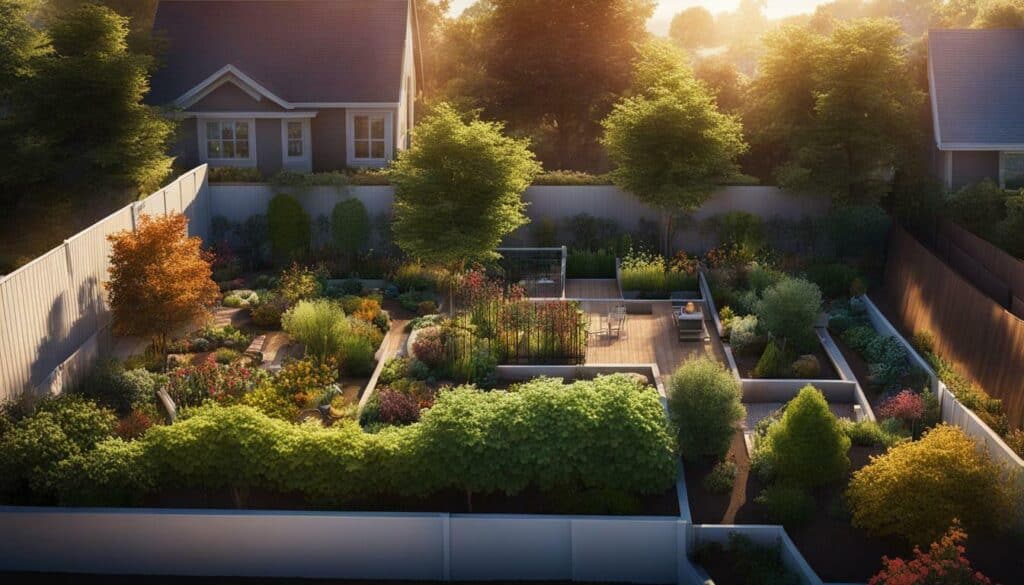
Choosing the right location for your vegetable garden is crucial to ensure the success of your plants. Consider factors such as sunlight requirements, well-drained soil, wind protection, and ideal garden conditions. By providing these optimal conditions, your vegetable garden will flourish and yield a bountiful harvest.
Choosing the Right Garden Size
When it comes to garden size, it’s better to start small and focus on quality over quantity. A smaller garden allows beginner vegetable gardeners to learn the basics and gain confidence before expanding their gardening endeavors. Here’s how to determine the perfect size for your beginner vegetable garden.
Assessing Your Space
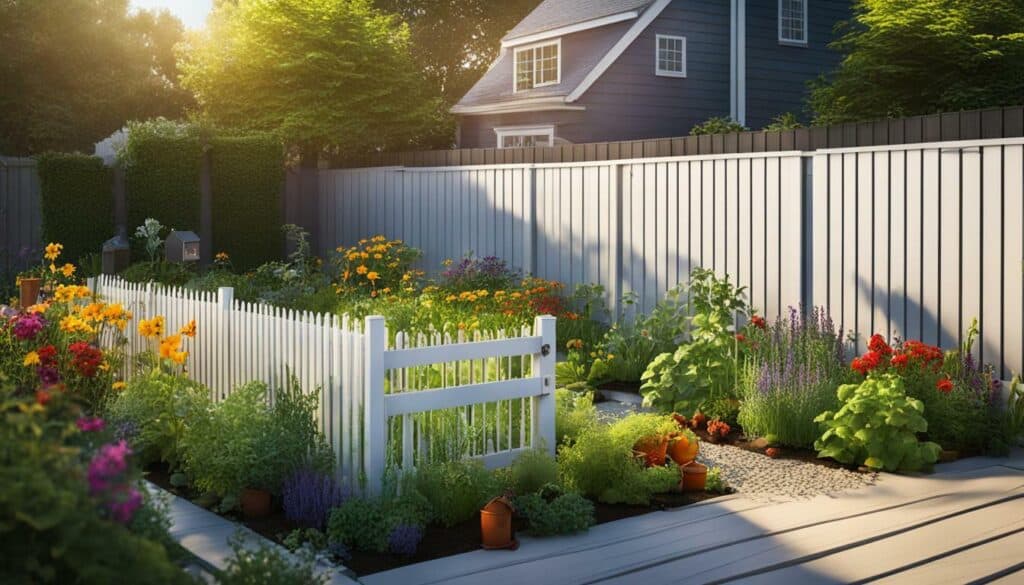
Before determining the size of your vegetable garden, assess the space available to you. Consider your yard or outdoor area, as well as any limitations or restrictions you may have. If you have a small backyard or a limited balcony space, starting with a smaller garden is a practical choice.
Benefits of a Small Vegetable Garden
There are several benefits to starting with a small vegetable garden:
- Manageability: A smaller garden is more manageable, especially for beginners who may not have much gardening experience. It allows you to focus your efforts and ensure proper care for your plants.
- Easier Maintenance: With a smaller garden, you’ll spend less time weeding, watering, and tending to your plants. This frees up time for other activities and reduces the risk of feeling overwhelmed.
- Lower Costs: A smaller garden requires fewer resources, such as soil, seeds, and fertilizers. It also reduces the risk of wasting produce if you’re unable to consume or preserve a large harvest.
Determining the Size
The size of your beginner vegetable garden will depend on various factors, including your available space, time commitment, and personal preferences. Here are some guidelines to help you determine the perfect size:
- In-Ground Garden: If you’re planting directly in the ground, a 10′ x 10′ garden (100 square feet) is a manageable size for beginners. Select 3 to 5 of your favorite vegetables and buy 3 to 5 plants of each kind.
- Raised Bed Garden: A 4′ x 4′ or 4′ x 8′ raised bed is an excellent option for beginners. It provides a defined space and makes it easier to control soil quality and drainage. Fill your raised bed with nutrient-rich soil and choose a variety of vegetables to grow.
- Expanding Your Garden: If you’re eager to grow more, consider a 12′ x 24′ garden in the ground. However, it’s advisable to start small and gradually expand your garden as you gain experience.
Remember to leave enough space between your plants for easy access and maintenance. Plan for paths every four feet or so to allow for weeding, harvesting, and watering without stepping on the soil.
Maximizing Space with Raised Beds
Using raised beds in your vegetable garden can be a smart choice, especially if you have limited space or poor soil quality. Raised beds offer improved drainage, better control over soil quality, and easier access to your plants. They also allow you to create a more organized and visually appealing garden layout.
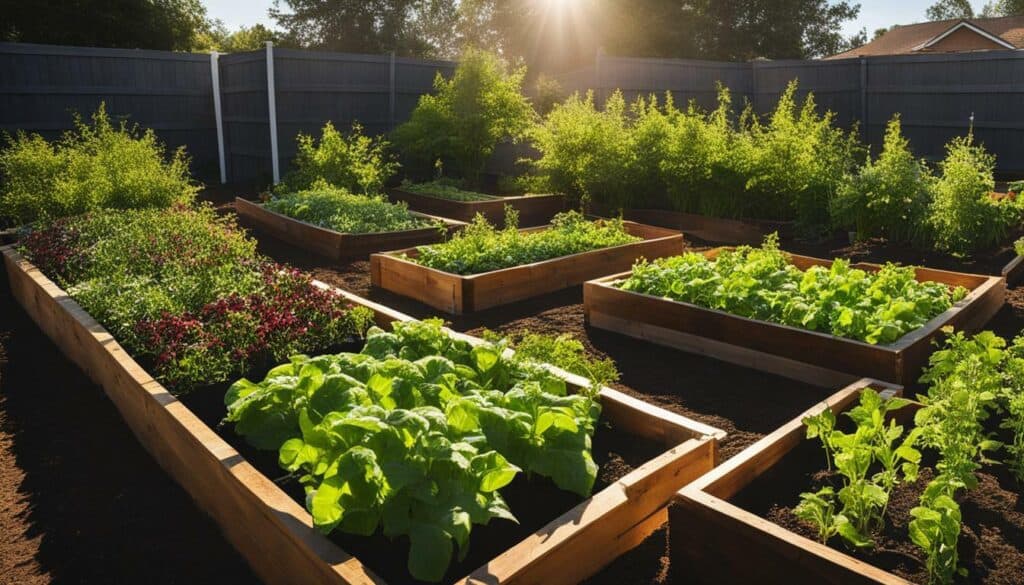
Consider using a raised bed that is 4′ x 4′ or 4′ x 8′. This size provides ample space for a variety of vegetables and makes it easier to reach the center of the bed for maintenance tasks. Fill your raised bed with a mixture of compost, organic matter, and good-quality soil to create an optimal growing environment for your plants.
Conclusion
Starting with a small garden size is the ideal way for beginner vegetable gardeners to learn and grow. It allows for manageable maintenance, reduces costs, and provides a sense of accomplishment. Whether you choose an in-ground garden or opt for raised beds, remember to start small and gradually expand as you gain confidence and experience. With patience and dedication, your small vegetable garden can yield bountiful harvests and bring you joy as you savor the taste of homegrown produce.
Choosing the Right Vegetables
Now that you have your garden set up, it’s time to choose the vegetables that will thrive in your beginner garden. Here are some top recommendations for easy-to-grow vegetables:
Top 10 Easiest Vegetables to Grow
- Lettuce: This leafy green is quick to grow and can be harvested multiple times, providing a continuous supply of fresh salads.
- Green beans: These fast-growing legumes are great for beginners and can be grown vertically to save space.
- Radishes: Radishes are one of the fastest-growing vegetables, ready for harvest in just a few weeks. They add a crisp and peppery flavor to salads and snacks.
- Tomatoes: While tomato plants are best started from transplants, they are a must-have in any vegetable garden. Choose determinate varieties for compact growth or indeterminate varieties for continuous harvesting throughout the season.
- Zucchini: These prolific plants produce an abundance of squash and are known for their ease of growth. Be prepared for an overload of zucchini!
- Peppers: Whether sweet or hot, peppers are a versatile vegetable that can be grown from transplants. They thrive in warm weather and add flavor to a variety of dishes.
- Beets: Beets are a root vegetable that can be grown directly in the ground. They are low-maintenance and offer both the roots and greens for consumption.
- Carrots: Carrots are another root vegetable that can be sown directly in the soil. Choose shorter and stumpier varieties for easier growing.
- Chard, Spinach, or Kale: These leafy greens are packed with nutrients and can be grown in both cool and warm seasons. They are perfect for salads and sautés.
- Peas: Peas are a cool-season crop that can be grown from seeds. They are delicious when eaten fresh or can be frozen for later use.
When choosing your vegetables, consider what you and your family enjoy eating. Select vegetables that are easy to grow, productive, and suitable for your climate. It’s also a good idea to check with your state’s Cooperative Extension Service for recommendations on plants that thrive in your area. By choosing the right vegetables, you’ll set yourself up for a successful and rewarding gardening experience!
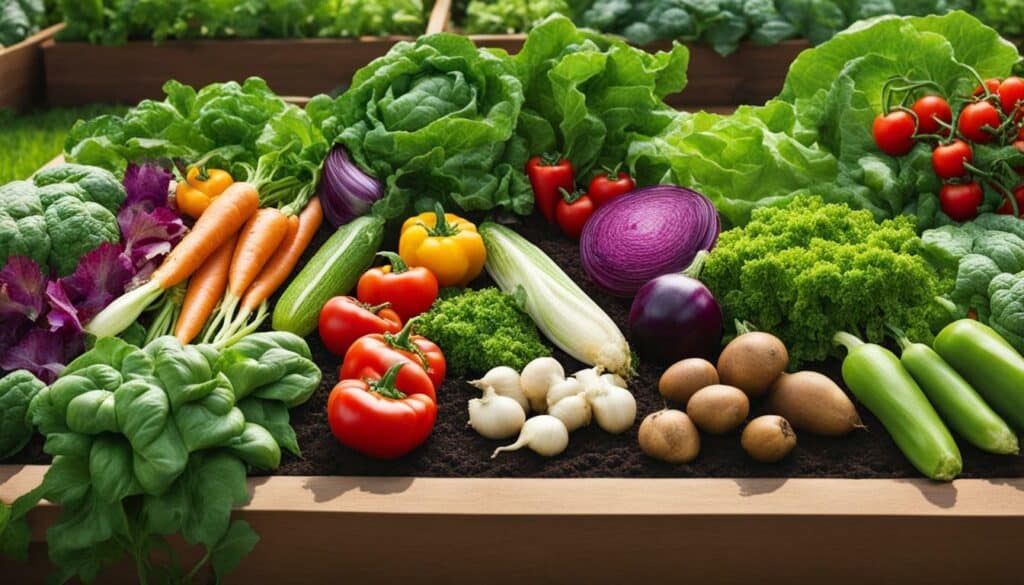
Now that you have an idea of the easiest vegetables to grow, it’s time to start planning your garden layout and considering how to start seeds and transplant seedlings. In the next sections, we will guide you through the process of starting seeds and provide essential tips on watering, fertilizing, pest and disease management, harvesting, and troubleshooting common garden issues. By following these tips, you’ll be well on your way to a thriving vegetable garden and enjoying the fruits of your labor.
Starting Seeds and Transplants
Whether you prefer starting from seeds or using transplants, this section will guide you through the process of getting your vegetable plants off to a healthy start.
When it comes to starting your vegetable garden, one of the first decisions you’ll need to make is whether to start from seeds or use transplants. Both methods have their advantages and it ultimately depends on your preferences and circumstances. Here are some tips to help you succeed in starting seeds and transplanting seedlings:
Starting Seeds
If you’re starting from seeds, proper germination is key to ensure healthy seedlings. Follow these steps:
- Sowing Seeds: Begin by selecting high-quality seeds that are suitable for your growing conditions. Read the seed packet instructions for information on when and how to sow the seeds. Prepare a seed tray or individual containers by filling them with seed-starting mix.
- Indoor Seed Starting: Place the seeds in the prepared containers according to the recommended spacing. Moisten the soil with a gentle spray of water and cover the containers with a clear plastic dome or plastic wrap to create a greenhouse-like environment. Keep the seeds in a warm and well-lit area, such as near a sunny window or under grow lights.
- Germination: Check the seed trays daily for signs of germination. Once the seedlings emerge, remove the plastic cover and provide them with adequate light, ensuring they receive at least 14-16 hours of light per day. It’s important to keep the soil consistently moist but not waterlogged during this stage.
- Hardening Off: Before transplanting the seedlings into the garden, they need to be gradually acclimatized to outdoor conditions. This process, known as hardening off, prevents shock and helps the plants adjust to temperature and sunlight fluctuations. Begin by placing the seedlings outdoors in a protected area for a few hours each day and gradually increase the time over the course of a week.
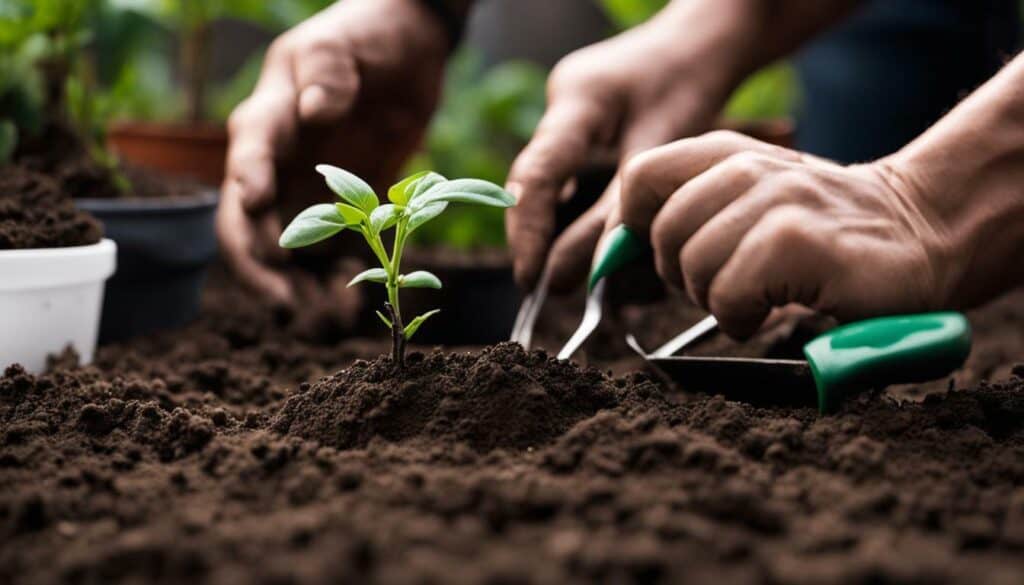
Transplanting Seedlings
If you opt to use transplants, follow these steps for successful transplantation:
- Choosing Healthy Transplants: Select transplants that have robust stems, vibrant leaves, and no signs of pests or diseases. Avoid leggy or weak-looking seedlings.
- Preparing the Garden: Before transplanting, ensure that your garden soil is well-prepared and free from weeds. Amend the soil with compost or organic matter to provide nutrients and improve drainage.
- Timing: Transplant seedlings into the garden when the risk of frost has passed and the soil temperatures are consistently warm. Follow the recommended spacing guidelines for each vegetable to allow proper growth and airflow.
- Digging the Hole: Dig a hole that is slightly larger than the root ball of the transplant. Gently remove the seedling from its container, being careful not to damage the roots, and place it in the hole. Backfill the hole with soil, firming it gently around the transplant.
- Watering: After transplanting, give the seedlings a thorough watering to help them establish their root systems. Continue to water regularly, ensuring that the soil remains consistently moist but not waterlogged.
Remember, whether you’re starting from seeds or using transplants, providing your plants with the right amount of water, sunlight, and nutrients is crucial for their growth and development. Be patient and observe your plants closely, making necessary adjustments along the way. With proper care, your vegetable garden will flourish and reward you with a bountiful harvest.
Proper Watering and Fertilizing for Healthy Vegetable Plants
Proper watering and fertilizing are crucial for the optimal growth and productivity of your vegetable plants. Providing the right amount of water and nutrients will ensure that your plants thrive and produce a bountiful harvest. Here’s what you need to know:
Watering Vegetables
Watering your vegetables is essential to keep them hydrated and promote healthy root development. Most vegetables require about 1 inch of water per week, either from rainfall or irrigation. However, it’s important to adjust watering based on weather conditions, soil type, and plant needs. Here are some tips:
- Check the soil moisture: Before watering, check the soil moisture by sticking your finger about an inch deep into the soil. If it feels dry, it’s time to water.
- Water deeply and infrequently: Instead of frequent shallow watering, give your plants a deep soak to encourage strong root growth. This will also help prevent water stress.
- Water in the morning: Watering in the morning allows the foliage to dry out during the day, reducing the risk of fungal diseases. Avoid watering in the evening to prevent prolonged leaf wetness.
- Use a drip irrigation system: Drip irrigation delivers water directly to the plant’s root zone, minimizing water waste and reducing the risk of foliar diseases.
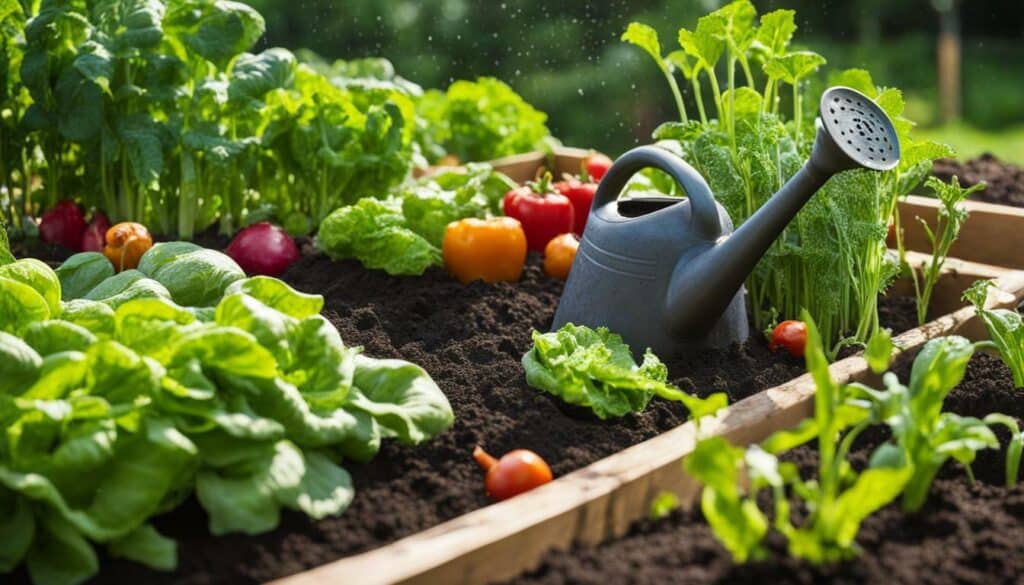
Fertilizing Plants
Fertilizing your vegetable plants provides them with essential nutrients for growth, flowering, and fruit production. Here are some guidelines for fertilizing:
- Test your soil: Before fertilizing, it’s important to test your soil to determine its nutrient content. This will help you choose the right fertilizer and avoid over or under-fertilizing.
- Choose organic fertilizers: Organic fertilizers, such as compost and well-rotted manure, provide slow-release nutrients and improve soil structure. They are a sustainable and environmentally-friendly choice for your vegetable garden.
- Follow recommended rates: Read the instructions on the fertilizer package and apply the recommended amount for your specific crop. Over-fertilizing can lead to nutrient imbalances and plant stress.
- Apply fertilizer at the right time: Generally, it’s best to apply fertilizer before planting or as a side-dressing during the growing season. Follow the specific recommendations for each vegetable variety.
- Monitor plant response: Observe your plants for signs of nutrient deficiency or excess, such as yellowing leaves or stunted growth. Adjust your fertilization practices accordingly.
By providing your vegetable plants with adequate water and nutrients, you can ensure their health and maximize their productivity. Remember to monitor your plants’ needs and make adjustments as necessary. Happy gardening!
Keeping pests and diseases at bay is essential to protect the health and vitality of your vegetable garden. Learn how to effectively manage common pests and prevent diseases.
Pests and diseases can wreak havoc on your vegetable garden, causing damage to your plants and reducing your harvest. It’s important to take proactive measures to keep these issues under control. Here are some organic pest management techniques and natural remedies you can use to protect your vegetables:
Common Vegetable Pests
| Pest | Description | Management |
|---|---|---|
| Aphids | Small, pear-shaped insects that feed on plant sap |
|
| Slugs and Snails | Mollusks that chew on foliage and leave slime trails |
|
| Cabbage Worms | Green caterpillars that feed on cabbage family plants |
|
These are just a few examples of common pests that can affect your vegetable garden. By familiarizing yourself with the pests that are prevalent in your area, you can take targeted measures to control them effectively.
In addition to pests, diseases can also pose a threat to your vegetable garden. Here are some disease prevention strategies to keep your plants healthy:
- Practice crop rotation to prevent the buildup of disease-causing organisms in the soil
- Provide adequate spacing between plants to promote good air circulation
- Water plants at the base to avoid wetting foliage, which can encourage disease
- Remove and destroy infected plants to prevent the spread of disease
- Use disease-resistant varieties when available
“Prevention is the best medicine when it comes to managing pests and diseases in your vegetable garden. By taking the time to implement these proactive strategies, you can minimize the risk and enjoy a bountiful harvest.”
Remember, it’s important to regularly inspect your plants for any signs of pests or diseases. Early detection and intervention can greatly reduce the impact on your garden. By following these organic pest management techniques and disease prevention strategies, you can create a healthy and thriving vegetable garden.
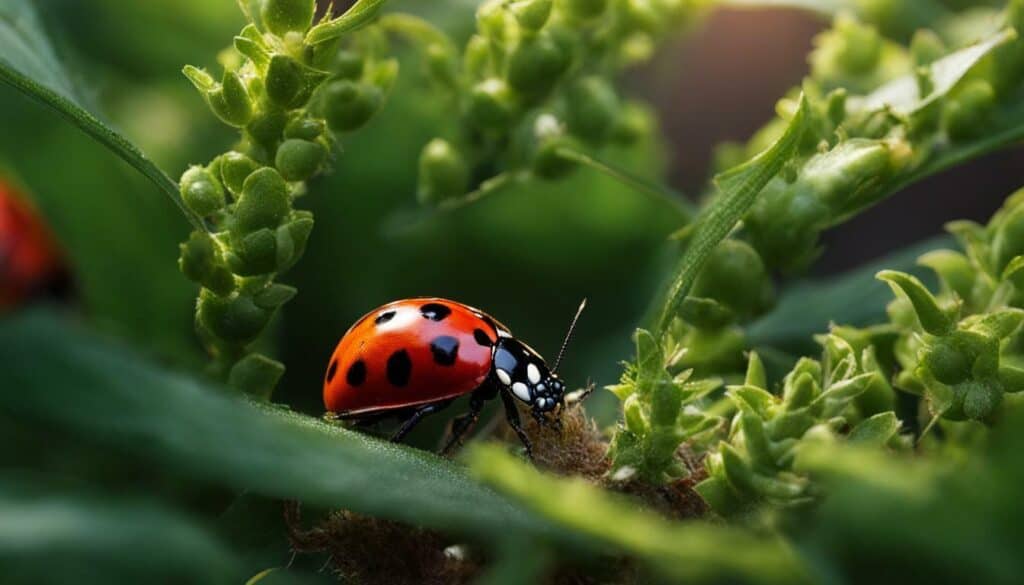
The moment of harvest is when all your hard work pays off. Discover the best practices for harvesting, handling, and storing your homegrown vegetables to keep them fresh and delicious.
Harvesting your homegrown vegetables is a rewarding experience. The sight of plump tomatoes, vibrant greens, and colorful peppers ready for picking is a testament to your efforts as a beginner vegetable gardener. But the work doesn’t end there – proper harvesting, handling, and storing are essential to ensure the freshness and flavor of your homegrown produce. Here are some best practices to follow:
- Harvest your vegetables at the right time: Each vegetable has its own optimal harvest time, which is usually indicated on the seed packet or plant label. Make sure to harvest your vegetables when they are fully ripe but still firm.
- Use sharp tools: To avoid damaging the plant, use sharp and clean tools such as pruning shears or a sharp knife to harvest your vegetables. This will ensure clean cuts and minimize the risk of disease transmission.
- Handle with care: Treat your freshly harvested vegetables gently to avoid bruising or crushing. Hold them by the stem or fruit, being careful not to exert too much pressure.
- Remove any debris: Before storing your vegetables, gently remove any soil, leaves, or other debris attached to them. This will help prevent the growth of bacteria or mold during storage.
Once you’ve harvested your vegetables, it’s time to store them properly to maintain their freshness and flavor. Here are some storage tips:
- Cool and dry storage: Most vegetables prefer cool and dry conditions for storage. Find a cool and well-ventilated area, such as a cellar or pantry, where the temperature and humidity can be controlled.
- Separate ethylene-producing vegetables: Some vegetables, such as tomatoes and apples, produce a natural gas called ethylene, which can accelerate the ripening process of other vegetables. Keep these ethylene-producing vegetables separate from others to prevent premature spoilage.
Preserving your homegrown vegetables is a great way to enjoy them throughout the year. Here are some preservation methods:
- Canning: Canning is a popular preservation method that involves sealing vegetables in jars with the help of heat. This method allows you to enjoy your homegrown vegetables long after the gardening season is over.
- Freezing: Freezing is another effective way to preserve the freshness of vegetables. Blanch your vegetables by briefly immersing them in boiling water, then cool them quickly in ice water before freezing in airtight containers or freezer bags.
- Drying: Drying vegetables removes moisture, preserving their flavor and nutritional value. You can air-dry certain vegetables, or use a dehydrator to speed up the process.
The moment of harvest is truly rewarding, but it’s important to handle and store your homegrown vegetables properly to maintain their freshness and flavor. By following these best practices, you can enjoy the fruits of your labor for months to come!

“Harvesting your own produce is a truly rewarding experience. The taste of homegrown vegetables is unmatched, and by following the proper harvesting and storage techniques, you can enjoy your hard work for even longer.” – Marylyn Abbott
Troubleshooting Common Garden Issues
Every gardener faces challenges along the way. Here’s how to identify and resolve common issues that may arise in your vegetable garden.
1. Garden Troubleshooting
When it comes to gardening, things don’t always go as planned. Here are a few common gardening problems and how to troubleshoot them:
| Problem | Solution |
|---|---|
| Garden pests |
|
| Plant diseases |
|
| Nutrient deficiencies |
|
2. Common Gardening Problems
Here are some common gardening problems that you may encounter and how to address them:
“A garden requires patient labor and attention. Plants do not grow merely to satisfy ambitions or to fulfill good intentions. They thrive because someone expended effort on them.” – Liberty Hyde Bailey
3. Plant Diseases and Pests
Plant diseases and pests can wreak havoc on your vegetable garden. Here are a few strategies to prevent and manage them:
- Practice good garden hygiene by removing diseased plants and debris.
- Rotate your crops annually to reduce the risk of disease buildup in the soil.
- Use organic pest control methods such as companion planting, physical barriers, and natural pest repellents.
4. Nutrient Deficiencies
Nutrient deficiencies can affect the growth and productivity of your vegetables. Common nutrient deficiencies include:
- Nitrogen deficiency: Symptoms include yellowing leaves and stunted growth. Apply organic nitrogen fertilizers to correct the deficiency.
- Phosphorus deficiency: Symptoms include purple or reddish discoloration of leaves. Incorporate organic phosphorus sources into the soil.
- Potassium deficiency: Symptoms include yellowing and browning of leaf margins. Apply organic potassium fertilizers to address the deficiency.
Regular soil testing can help identify nutrient deficiencies and guide you in applying the appropriate amendments.
5. Garden Pests
Garden pests can cause significant damage to vegetable plants. Here are some common garden pests and how to manage them organically:
- Aphids: Use a strong blast of water to dislodge aphids from plants or introduce natural predators like ladybugs.
- Slugs and snails: Set up beer traps or use copper barriers to deter slugs and snails from your garden.
- Cabbage worms: Handpick caterpillars or use organic insecticides like Bacillus thuringiensis (Bt).
6. Conclusion
Troubleshooting common garden issues is an important part of successful vegetable gardening. By identifying and resolving problems promptly, you can ensure healthy and productive plants. Remember to practice organic gardening techniques and stay vigilant in caring for your vegetable garden. Happy gardening!
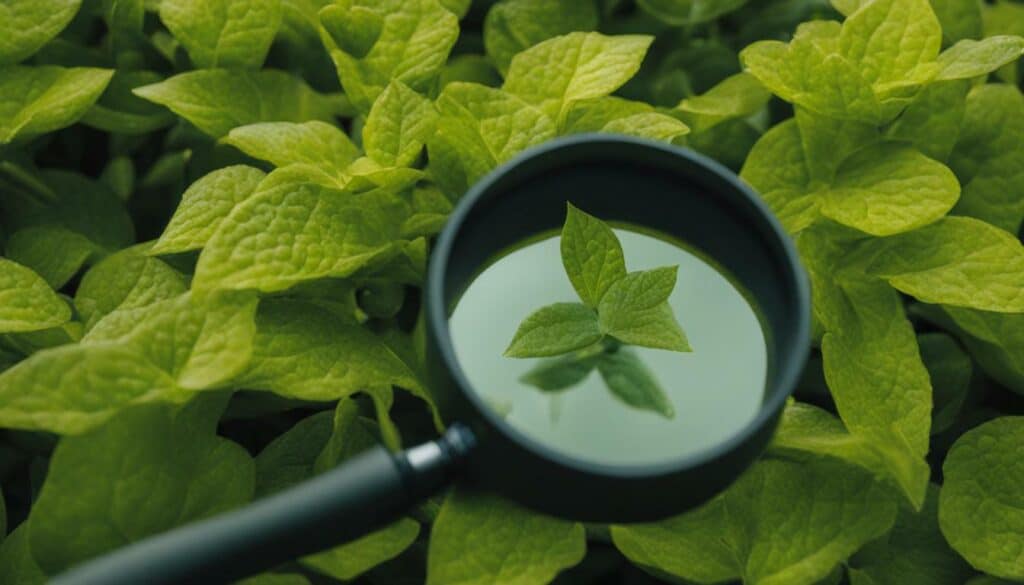
Congratulations! You are now equipped with my best vegetable growing tips for beginners. Follow these guidelines, have patience, and watch your garden flourish with delicious, homegrown vegetables!
Starting a vegetable garden can be both rewarding and delicious. There’s nothing quite like the taste of fresh, homegrown produce. Whether you have a small balcony or a spacious backyard, these vegetable gardening tips for beginners will help you get started on your journey to achieving a fruitful home garden.
Picking the Right Location
When choosing a location for your vegetable garden, consider the amount of sunlight it receives. Most vegetables need 6 to 8 hours of direct sunlight per day. If your space has some shade, opt for leafy vegetables that can tolerate shade. Additionally, ensure that the soil drains well and doesn’t stay too wet, as this can lead to root rot. Finally, pick a location that is stable and protected from strong winds, as this can damage young plants.
Planning Your Garden Size
Start small when it comes to your garden size. It’s better to have a small garden that you can manage and enjoy rather than an overwhelming one. A 10′ x 10′ garden is a manageable size for beginners. Pick 3 to 5 of your favorite vegetables and buy 3 to 5 plants of each. If you prefer raised beds, a 4′ x 4′ or 4′ x 8′ size is a good option. Remember to leave enough space between the rows or beds for easy access to weed and harvest.
Choosing the Right Vegetables
When selecting vegetables to grow, choose ones that you and your family enjoy eating. Start with easy-to-grow vegetables such as lettuce, green beans, radishes, tomatoes (by transplant), zucchini, peppers (by transplant), beets, carrots, chard, spinach, kale, and peas. Consider your climate and growing season when choosing vegetables and consult your local Cooperative Extension Service for expert advice on what grows best in your area.
Starting Seeds and Transplants
If you’re starting from seeds, follow the instructions on the seed packets for optimal planting and germination. Indoor seed starting is a great way to get a head start on the growing season. Once your seedlings are ready, harden them off by gradually exposing them to outdoor conditions before transplanting them into the garden. This helps them adjust to the change in environment.
Best Practices for Watering and Fertilizing
Proper watering and fertilizing are essential for healthy plant growth. Water your vegetables regularly, providing enough moisture to keep the soil evenly moist but not waterlogged. Consider using irrigation methods such as soaker hoses or drip irrigation to minimize water waste. When it comes to fertilizing, use organic fertilizers and follow the recommended application rates. Establish a regular watering and fertilizing schedule to help your plants thrive.
Pest and Disease Management
Pests and diseases can pose challenges in your vegetable garden. Practice organic pest management by using natural remedies and deterrents. Identify common vegetable pests in your area and take preventive measures to protect your plants. Regularly inspect your plants for signs of disease and take immediate action to prevent the spread. Proper sanitation and crop rotation can also help minimize pest and disease problems.
Harvesting and Storing Your Vegetables
Harvest your vegetables when they are ripe and ready. Different vegetables have different indicators of ripeness, such as color, size, and firmness. Proper harvesting techniques ensure that you get the best flavor and quality from your produce. After harvesting, handle your vegetables with care and store them properly to maintain their freshness and flavor. Consider preserving excess vegetables through canning, freezing, or drying for future use.
Troubleshooting Common Garden Issues
Even the most experienced gardeners encounter challenges in the garden. Common issues include plant diseases, nutrient deficiencies, and garden pests. If you notice any problems, don’t panic. Take the time to diagnose the issue and implement appropriate solutions. Your local Cooperative Extension Service can provide valuable guidance and resources to help you overcome these challenges.
Conclusion
By following these vegetable growing tips for beginners, you’re well on your way to achieving a successful and fruitful home garden. Remember to start small, choose the right location, select the right vegetables, and practice proper care and maintenance. With patience and dedication, you’ll enjoy the satisfaction of growing your own delicious, homegrown vegetables. Happy gardening!
FAQ
Q: What are some beginner-friendly vegetables to grow?
A: Some easy vegetables for beginners to grow include lettuce, green beans, radishes, tomatoes (by transplant), zucchini, peppers (by transplant), beets, carrots, chard, spinach, kale, and peas.
Q: How do I choose the right location for my vegetable garden?
A: When choosing a location for your vegetable garden, consider factors such as sunlight (most vegetables need 6 to 8 hours of direct sunlight per day), well-drained soil, protection from strong winds, and stable ground that doesn’t flood easily.
Q: What size should my vegetable garden be?
A: If planting in the ground, a 10’ x 10’ garden (100 square feet) is a manageable size for beginners. If planting in a raised bed, a 4’ x 4’ or 4’ x 8’ is a good beginner size. If you want to go bigger, a 12’ x 24’ garden in the ground is probably the biggest a first-timer should go.
Q: How do I choose the right vegetables for my garden?
A: Choose vegetables that you and your family enjoy eating. Consider the availability of certain vegetables in your area and the amount of produce your family can consume. It’s also important to consider your ability to take care of the plants throughout the growing season, especially if you’ll be away for extended periods of time.
Q: When should I start planting my vegetables?
A: The timing of planting vegetables depends on whether they are cool-season or warm-season crops. Cool-season vegetables like lettuce, broccoli, and peas should be planted in the cooler weather of early spring and fall, while warm-season vegetables like tomatoes, peppers, and cucumbers are planted when the soil warms up in late spring and summer.
Q: How often should I water and fertilize my vegetable garden?
A: Water your vegetable garden frequently during the first few weeks after seeds germinate or seedlings are transplanted. Once your plants are established, give your garden a long drink every few days rather than a little sprinkle every day to encourage root growth. When it comes to fertilizing, use organic fertilizers and follow the recommended dosage instructions on the product.
Q: How can I manage pests and diseases in my vegetable garden?
A: Practice organic pest management by attracting beneficial insects, using natural remedies like neem oil or insecticidal soap, and practicing good garden hygiene by removing diseased plant material. Regularly inspect your plants for signs of pests or diseases and take action early to prevent further damage.
Q: How do I harvest and store my vegetables?
A: Harvest vegetables when they are ripe and ready to eat. Different vegetables have different harvesting techniques, so refer to specific growing guides for each vegetable. Properly clean and dry harvested vegetables before storing them in a cool, dark, and dry place. Some vegetables can also be preserved through canning, freezing, or drying.
Q: What should I do if I encounter common garden issues?
A: If you encounter common garden issues like plant diseases, nutrient deficiencies, or garden pests, research the specific problem and follow recommended solutions. This can include adjusting soil pH, providing appropriate nutrients, practicing crop rotation, and using organic pest control methods.
Why are Raised Garden Beds Recommended for Beginner Vegetable Gardeners?
Raised garden beds are highly recommended for beginner vegetable gardeners due to their many advantages. With basic raised garden bed plans, newcomers can easily create a suitable growing environment for their plants. These beds offer better control over soil quality, drainage, and weed management. Their raised height also facilitates convenient maintenance and reduces the risk of back strain. Additionally, raised garden beds help beginners learn essential gardening techniques while producing healthy and thriving vegetables.

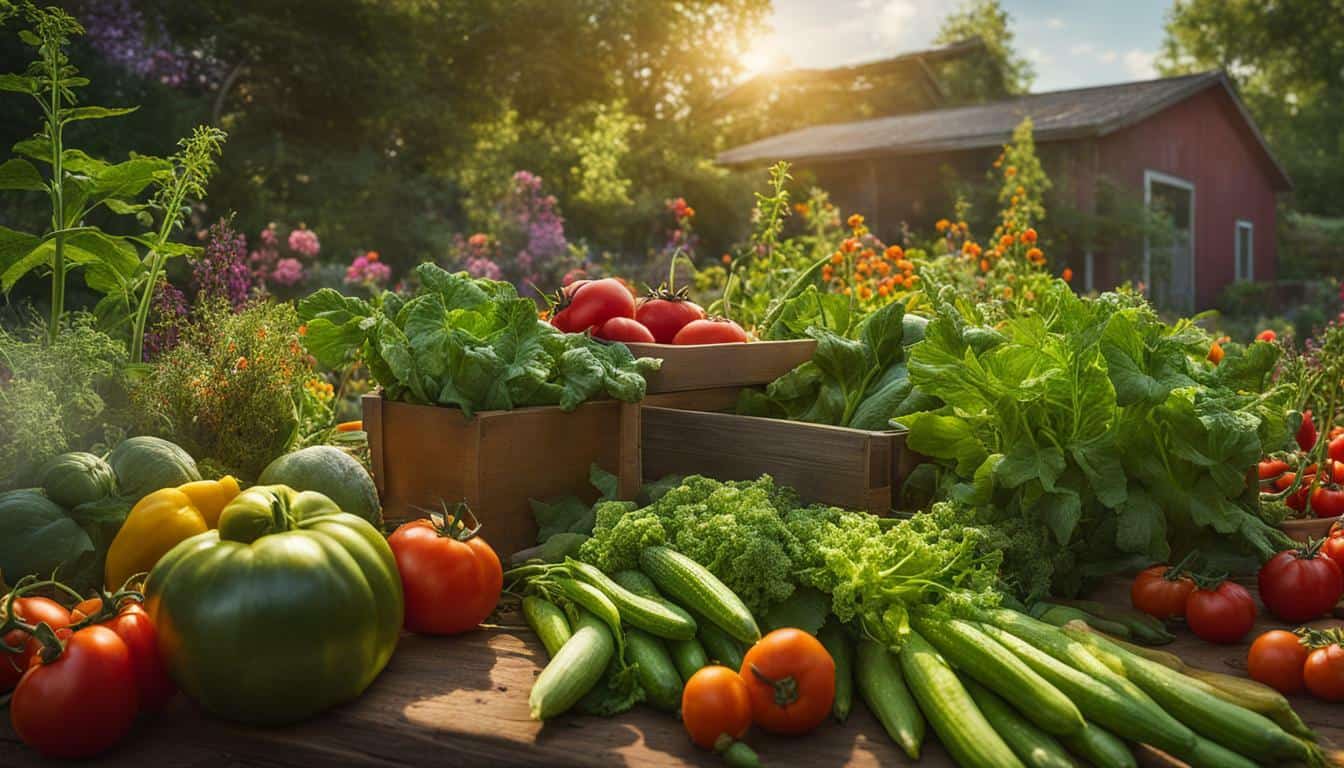



Leave a Reply